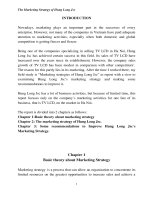Diversification strategy lessson
Bạn đang xem bản rút gọn của tài liệu. Xem và tải ngay bản đầy đủ của tài liệu tại đây (304.92 KB, 34 trang )
Diversification Strategy
Diversification Strategy
•
Introduction: The Basic Issues
•
The Trend over Time
•
Motives for Diversification
- Growth and risk spreading
- Diversification and Shareholder Value: Porter’s
Three Essential Tests.
•
Competitive Advantage from Diversification
•
Diversification and Performance: Empirical Evidence
•
Relatedness in Diversification
OUTLINE
Objectives
•
Define corporate strategy, describe some of
the reasons why firms diversify, identify
and describe different types of corporate
diversification, and assess the advantages
and disadvantages associated with each.
•
Identify sources of synergy in diversified
firms while also describing why synergies
are so difficult to achieve.
Objectives (cont.)
•
Explore the complex relationship between
diversification and firm performance.
•
In particular, explore the influence of
managers and managerial thinking on the
relationship between diversification and
performance.
Introduction
•
Definition of Corporate Strategy
–
Address the question: “What is the appropriate scale
and scope of the enterprise?”
•
Influences how large and how diversified firms will be.
•
Successful corporate strategies are not only the product of
successful definition
–
Also the result of organizational capabilities or competencies that
allow firms to exploit potential economies/synergies that large
size or diversity can offer.
Introduction (cont.)
•
Why Firms Diversify
–
To grow
–
To more fully utilize existing resources and
capabilities.
–
To escape from undesirable or unattractive
industry environments.
–
To make use of surplus cash flows.
Introduction (cont.)
•
Horizontal or related diversification
–
Strategy of adding related or similar product/service
lines to existing core business, either through
acquisition of competitors or through internal
development of new products/services.
Introduction (cont.)
•
Horizontal or related diversification
–
Advantages
•
Opportunities to achieve economies of scale and
scope.
•
Opportunities to expand product offerings or expand
into new geographical areas.
Disadvantages of related diversification
•
Complexity and difficulty of coordinating different
but related businesses.
Introduction (cont.)
Conglomerate or unrelated diversification
–
Firms pursue this strategy for several reasons:
•
Continue to grow after a core business has matured
or started to decline.
•
To reduce cyclical fluctuations in sales revenues and
cash flows.
–
Problems with conglomerate or unrelated
diversification:
•
Managers often lack expertise or knowledge about
their firms’ businesses.
Introduction: The Basic
Issues
Introduction: The Basic
Issues
Diversification decisions involve two basic issues:
•
Is the industry to be entered more attractive than
the firm’s existing business?
•
Can the firm establish a competitive advantage
within the industry to be entered? (i.e. what
synergies exist between the core business and
the new business?)
Aim of Corporate Strategy:
Synergy
•
Aim of diversification should be to create
value or wealth in excess of what firms
would enjoy without diversification.
•
Synergy: the value of the combined firm
after acquisition should be greater than the
value of the two firms prior to acquisition.
–
Obtained in three ways:
•
Exploiting economies of scale.
–
Unit costs decline with increases in production.
Aim of Corporate Strategy:
Synergy (cont.)
•
Exploiting economies of scope.
–
Using the same resource to do different things.
•
Efficient allocation of capital.
–
Many assets in acquired firms are undervalued
managers seek to exploit these opportunities and improve
their operations and add value to their businesses.
Relatedness in
Diversification
Relatedness in
Diversification
Synergy in diversification derives from two main types of
relatedness:
•
Operational Relatedness synergies from sharing
resources across businesses (common distribution
facilities, brands, joint R&D)
•
Strategic Relatedness synergies at the corporate level
deriving from the ability to apply common management
capabilities to different businesses.
Problem of operational relatedness:- the benefits in terms
of economies of scope may be dwarfed by the
administrative costs involved in their exploitation.
Problems in Exploring Potential
Synergies
•
Poor understanding of how diversification
activities will “fit” or be coordinated with
existing businesses.
•
Acquisition process is fraught with risks.
–
Managers might fail to conduct an adequate
strategic analysis of acquisition candidate.
•
Will often try to complete the deal too quickly
before other potential buyers begin a bidding war.
•
Managers will often focus on the attractive features
of a candidate, while giving less attention to the
negative features.
Problems in Exploring Potential
Synergies (cont.)
–
Even after making an acquisition, managers
must still integrate the new business into their
company’s existing portfolio of businesses.
•
Differences in organizational cultures.
•
Should new business be standalone operation or
should it be merged into one of the existing
businesses?
Problems in Exploring Potential
Synergies (cont.)
•
Problems associated with internal
development of new businesses.
–
Most problems due to considerable time and
investment required to launch new business.
•
On average, most new product lines require 10 years
before generating positive cash flows and net
income.
–
Difficult to assess the risks associated with new
investment opportunity.
The Trend Over Time: Diversified
Companies among the Fortune 500
Percentage of Specialized Companies (single-business,
vertically-integrated and dominant-business)
Percentage of Diversified Companies (related-business
and unrelated business)
BUT Since late 1970’s, diversification has declined.
1949 1954 1959 1964 1969 1974
70.2 63.5 53.7 53.9 39.9 37.0
29.8 36.5 46.3 46.1 60.1 63.0
Diversification and Performance:
The Score
•
What is relationship between diversification
and firm performance?
–
Academics, consultants,and financial
community have dim view of diversification.
–
Some studies suggest that diversification
beyond a core business leads to lower
performance.
Diversification and Performance:
Empirical Evidence
Diversification and Performance:
Empirical Evidence
•
Diversification trends have been driven by beliefs rather
than evidence:- 1960s and 70s diversification believed to
be profitable; 1980s and 90s diversification seen as value
destroying.
•
Empirical evidence inconclusive no consistent findings
on impact of diversification on profitability, or on related
vs. unrelated diversification.
•
Some evidence that high levels of diversification
detrimental to profitability
•
Diversifying acquisitions,
on average, destroy share-
holder value for acquirers
•
Refocusing generates
positive shareholder returns
1 2 3 4 5 6
index of product diversity
3
2
1
return on net assets (%)
Diversification and Performance: The
Score (cont.)
–
Exhibit summarizes findings of study that
sought to determine how much various factors,
including industry attractiveness, business
strategy, and corporate strategy contribute to
performance.
•
Findings suggest that industry attractiveness and
business strategy together explain more than 99% of
variation of business unit performance.
–
Corporate strategy has no apparent effect on performance!
Diversification and Performance: The
Score (cont.)
–
Additional studies conclude that corporate
strategy rarely makes significant contribution to
shareholder value.
–
Recent study is shown in Exhibit below:
46
47
47
46
Low-
Performing
Firms
Less
Diversified
High-
Performing
Firms
Diversification and Performance: The
Score (cont.)
–
Exhibit suggests:
•
Categorization of firms into the 4 diversification-
performance groups is remarkably balanced.
–
High-performing firms are just as likely to be more
diversified as they are to be less diversified.
–
Low-performing firms are just as likely to be less
diversified as they are to be more diversified.
•
No significant performance differences between
high-performing more or less diversified firms.
Diversification and Performance: The
Score (cont.)
•
Summary
–
Though diversification has been disastrous for
many firms, diversified firms can also be
successful.
–
Studies have found no obvious differences
between high- and low-performing diversified
firms along several important strategic
dimensions.
Motives for
Diversification
Motives for
Diversification
GROWTH The desire to escape stagnant or declining industries
has been one of the most powerful motives for
diversification (tobacco, oil, defense).
But, growth satisfies management not shareholder
goals.
Growth strategies (esp. by acquisition), tend to
destroy shareholder value
RISK Diversification reduces variance of profit flows
SPREADING But, does not normally create value for
shareholders, since shareholders can hold diversified
portfolios.
Capital Asset Pricing Model shows that
diversification lowers unsystematic risk not
systematic risk.
PROFIT For diversification to create shareholder value, the act
of bringing different businesses under common owner-
ship must somehow increase their profitability.
Diversification and Shareholder Value:
Porter’s Three Essential Tests
Diversification and Shareholder Value:
Porter’s Three Essential Tests
If diversification is to create shareholder value, it must meet
three tests:
1. The Attractiveness Test: diversification must be directed
towards actual or potentially-attractive industries.
2. The Cost of Entry Test : the cost of entry must not capitalize
all future profits.
3. The Better-Off Test: either the new unit must gain
competitive advantage from its link with the corporation, or
vice-versa. (i.e. synergy must be present)
Introduction: The Tasks of Corporate
Strategy In the Multibusiness Corporation
Introduction: The Tasks of Corporate
Strategy In the Multibusiness Corporation
•
Determining the company’s business portfolio
diversification, acquisition, divestment
•
Allocating resources between the different businesses
•
Formulating strategy for the different businesses
•
Controlling business performance
•
Coordinating the businesses and creating overall
cohesiveness and direction for the company









